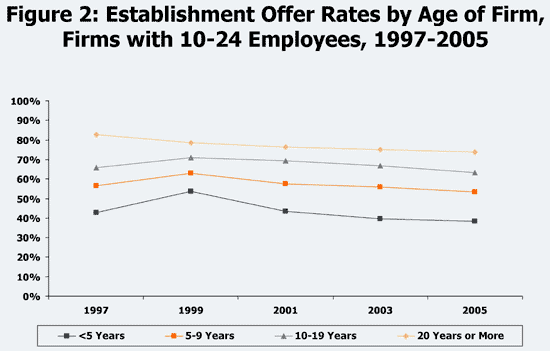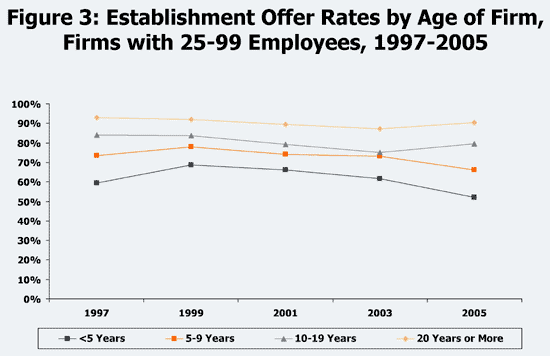Snapshots: Offer Rates for Smaller Establishments by Business Age
Employer-provided health insurance is the primary source of insurance coverage in the United States, covering almost 160 million people or more than 90 percent of the non-elderly privately-insured population.1 In recent years, the percentage of firms who offer such benefits has been falling; 69 percent offered health coverage benefits in 2000, whereas 60 percent did the same in 2007.2 Since employers are not required to offer health benefits to their employees, changes in the rate at which they offer such benefits are important for understanding the number of people covered by private insurance. Having access to work-place health insurance is a key determinant of whether or not a person has private coverage.
Researchers looking at the reasons why employers offer coverage have identified a variety of factors. These include both employee characteristics, such as earnings, occupation, part-time versus full-time status, union status, gender, and age, and employer characteristics, such as geographic region, industry, and firm and establishment size.3
This issue brief looks at a less well-understood factor that may also affect an employer’s decision to offer health benefits: how long a business has been operating. We show that, among smaller and mid-sized establishments, the likelihood of offering coverage is associated with the age of the business.
There are several reasons that the age of a business may affect a manager’s decision to offer health benefits. Newer businesses, particularly smaller ones, may have limited resources and profits, which may constrain their ability or willingness to provide benefits. Newer businesses also may be uncertain about their revenues, which could make them cautious about their ability to maintain benefits over time. Businesses may be reluctant to begin offering a benefit that they are not sure that they can retain. Also, employees interested in working for newer businesses may view health benefits as less important than workers who work for older, more established, businesses.
The analysis is based on data from the Insurance Component of the Medical Expenditure Panel Survey (MEPS-IC), conducted annually by the Agency for Healthcare Research and Quality.4 The MEPS-IC surveys a random sample of establishments and collects information about the establishment’s characteristics and health benefit offerings. Importantly for this analysis, establishments are asked how long their parent organization has been in business.5
We looked at whether or not private sector establishments offer benefits by three establishment size categories and by age of the business. Offer rates are shown for alternating years between 1997 and 2005. We confined the analysis to smaller establishments (less than 100 employees) for two reasons. First, most large establishments offer health benefits, so there is little variation in offer rates to explain. Second, the data on business age for larger establishments contained a relatively large number of missing values. A possible explanation for these missing values is that mergers and acquisitions among larger businesses may make it difficult for respondents to correctly identify the age of the parent organization.
Offer Rates by Establishment Size and Business Age, 1997 – 2005
The likelihood that a small establishment will offer health insurance varies considerably by the number of employees, so we divided establishments into three size categories (fewer than 10 workers, 10 to 24 workers, and 25 to 99 workers) for the analysis. Within each size category, the percentage of establishments offering health benefits clearly increases across the business age categories (Figures 1, 2 and 3).6 For example, looking at the year 2005 for establishments with fewer than 10 workers, 43 percent of establishments with a business age of 20 or more years offered health benefits, compared to 37 percent of establishments with business ages between 10 and 19 years, 32 percent of establishments with business ages between 5 and 9 years, and 24 percent for establishments with business ages of fewer than 5 years.7
In addition to being lower, the offer rates for the youngest businesses also are more volatile, with the youngest size category rising (from 1997 to 1999) and then falling (from 1999 to 2005) more quickly than the eldest business category for all three size groupings (Figures 1, 2, and 3).8 Younger businesses appear to be more susceptible to the economic conditions causing the overall reduction in offering, perhaps reflecting less economic stability or greater sensitivity to high or uncertain health care costs.

Source: Kaiser Family Foundation calculations using data from the U.S. Department of Health and Human Services, Agency for Healthcare Research and Quality, Medical Expenditure Panel Survey Insurance Component (MEPS-IC), 1997, 1999, 2001, 2003, and 2005.

Source: Kaiser Family Foundation calculations using data from the U.S. Department of Health and Human Services, Agency for Healthcare Research and Quality, Medical Expenditure Panel Survey Insurance Component (MEPS-IC), 1997, 1999, 2001, 2003, and 2005.

Source: Kaiser Family Foundation calculations using data from the U.S. Department of Health and Human Services, Agency for Healthcare Research and Quality, Medical Expenditure Panel Survey Insurance Component (MEPS-IC), 1997, 1999, 2001, 2003, and 2005.
Discussion
The analysis above shows that, for smaller establishments, those with younger business ages are less likely to offer health benefits than establishments with older business ages. The relationship generally holds across size categories. Offer rates for younger businesses also declined more quickly between 1999 and 2005 than they did for older businesses.
These findings suggest that policymakers interested in policies to boost health benefit offer rates may want to give special focus to the issues faced by smaller businesses starting-up or in the early years of operation. Special subsidies or special insurance products for these businesses or their workers may be needed in order to encourage more offering. Further research may be needed to better identify the factors causing lower offer rates among these businesses and tailor adequate responses. While the age of business is probably not useful as the primary criterion for policy interventions, given the importance of private health insurance in the United States, knowledge of the association between business age and health benefit offers can help policymakers and the public at large understand the factors which contribute to changes in health insurance coverage.
This paper was prepared by Paul Jacobs and Gary Claxton of the Kaiser Family Foundation’s Health Care Marketplace Project.
Notes:
1. Kaiser Commission on Medicaid and the Uninsured, “The Uninsured: A Primer,” Kaiser Family Foundation, October 2007. Available online at: http://www.kff.org/uninsured/7451.cfm.
2. Kaiser Family Foundation/Health Research and Educational Trust, Annual Survey of Employer Health Benefits, 2007. Available online at: http://www.kff.org/insurance/7672/index.cfm.
3. See, e.g., Jack Hadley and James D. Reschovsky, “Small Firms’ Demand for Health Insurance: The Decision to Offer Insurance,” Inquiry, vol. 39, Summer 2002, pp. 118–137; Jonathan Gruber and Michael Lettau, “How elastic is the firm’s demand for health insurance?” Journal of Public Economics, vol. 88, nos. 7-8, July 2004, pp. 1273-1293.
4. For more information on the MEPS-IC is available online at:http://www.meps.ahrq.gov/mepsweb/survey_comp/Insurance.jsp.
5. The question in the MEPS-IC establishment survey is, “Approximately how many years has your organization been in business? If your organization operates at more than one location, enter the number of years the parent company has been in business.” Agency for Healthcare Research and Quality, “Health Insurance Cost Study: Establishment Questionnaire,” 2005 Medical Expenditure Panel Survey, Insurance Component. Available online at:http://www.meps.ahrq.gov/mepsweb/survey_comp/survey_ic.jsp.
6. We tested the significance between age of business categories within each of the years shown (1997, 1999, 2001, 2003, and 2005) for each of the three establishment size categories. For Figures 1 and 2, which show, respectively, offer rates for establishments with fewer than 10 employees and for establishments with 10 to 24 workers, the offer rates for each year is significantly different than the offer rate for the business age above or below it at p<0.05.
For Figure 3, which shows offer rates for establishments with 25 to 99 workers, each of the offer rates for the years 1997, 1999, and 2005 are significantly different than the offer rate for the business age above or below it at p<0.05. For 2001 and 2003, the mean establishment offer rate for the oldest businesses is significantly greater than the offer rate for the business ages between 10 and 19 years at p<0.05. However, the offer rate for establishments with the youngest business ages was not statistically different from that for businesses with ages between five and nine years (although these were marginally insignificant at p=0.069 in 2001 and p= 0.055 in 2003), and the establishment offer rate for business ages between five and nine years were not statistically different than those between 10 and 19 years (p=0.137 and p=0.746 in 2001 and 2003, respectively). However, for all years shown in Figure 3, the mean establishment offer rate for the two younger business age categories are significantly lower than the offer rates for the oldest business age category (20+ years) at p<0.05.
7. The differences between each of these observations is statistically significant at p<0.05.
8. There was a larger rise in the offer rate from 1997 to 1999 and then a larger fall from 1999 to 2005 for the youngest businesses (less than 5 years) than that for the eldest businesses (those with 20 or more years). This difference was significant at p<0.05 for all three establishment sizes
